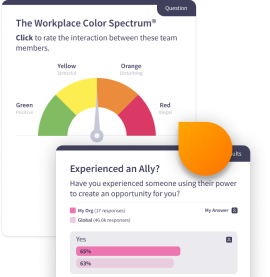An introduction to the purpose and goals of this course. Also, an introduction to the concept that team dynamics are influenced by peoples' culture skills.
Developing Our Respect Skill
An introduction to 2nd part of Preventing Workplace Harassment 13.
A refresher of the legal framework for workplace harassment and Emtrain’s Workplace Color Spectrum®, providing a shared language to color code conduct, not people.
The Workplace Color Spectrum® Tool
This lesson explains the Workplace Color Spectrum and how it can help managers and employees understand and categorize their conduct — and the conduct of others.
What Is Unlawful Harassment?
Workplace harassment always involves conduct or comments relating to "protected characteristics." But what are they, and which ones apply in my workplace?
Bullying and Aggressive Behavior
Help your employees understand, identify, and stop aggressive, bullying behavior in the workplace.
Types and Forms of Harassment
Teach learners about the different types of harassment and how "quid pro quo" is different than "hostile work environment".
What is Unwelcome Conduct?
A hostile work environment always involves "unwelcome conduct." This lesson addresses how to determine when conduct is legally considered "unwelcome."
Red conduct is illegal and negatively impacts work culture. Help employees determine what it looks like and how to know when conduct is crossing the line from orange to red.
Who Can Be Involved in Harassment?
This lesson explains the reach of workplace harassment laws, who is protected, and who can be liable for harassing conduct.
Help prevent potential problems by familiarizing yourself with some typical situations that can result in harassment or employee conflict.
There are a few common situations that seem to regularly lead to claims of harassment. By learning to recognize these situations, we can mitigate conflict and harassment, helping maintain a healthier workplace culture.
In most harassment situations, someone outside the conflict knows what's going on. How do you go from being a passive bystander to an upstander who takes action to de-escalate the problem and uphold respectful norms of behavior?
This lesson helps learners recognize ageist comments and actions, emphasizing that age is a legally protected characteristic and treating someone differently because of it is a workplace issue.
We all talk about our personal lives at work, and it’s easy to cross the line from chatter to negative gossip. This lesson teaches people to identify and stop gossip situations as quickly as possible to prevent harm to co-workers.
This lesson clarifies the limits of workplace speech, helping employees understand the difference between First Amendment rights and their responsibility to align speech with corporate values.
Help learners understand how generational differences, shaped by life experiences, can lead to workplace conflict and disrespect in today's multigenerational workforce.
Mental Health and Empathy
This lesson highlights the importance of treating employees with disabilities, including mental health conditions, with empathy and respect. It offers guidance for addressing performance concerns, reducing friction, and collaborating with HR to provide proper support.
Our laws and policies are designed to ensure equity and a level playing field between people, regardless of their race, gender, age, etc. And that includes all aspects of the employee experience, including processes and systems and how they’re applied to people.
As more people are working remotely, digital communications have become a crucial tool. Learn the best practices for digital communications whether email, instant messaging, etc., while preserving a respectful workplace.
This lesson explores family status as a protected characteristic and emphasizes the importance of being empathetic and flexible with working parents. It highlights the need to avoid stereotypes and assumptions, fostering a supportive and inclusive workplace.
Gender Identity, Expression, and Transition
Equip employees with the knowledge and tools to create a respectful and inclusive workplace for trans, non-binary, and gender non-conforming colleagues. This lesson focuses on understanding gender diversity, using appropriate language, and fostering a supportive environment where everyone feels valued and respected.
Everyone has a need to belong, leading to "in-groups" and "out-groups" in the workplace, based on shared identities and communities. This lesson helps learners recognize these dynamics and promote inclusivity to reduce friction.
Weight Stigma and Sizeism
Some states protect employees based on their physical size. This lesson reminds everyone to be respectful of others, regardless of their weight or appearance.
Religion is a protected characteristic, and it's important to be respectful and inclusive of the spiritual and religious practices of our co-workers — even if you do not personally share the same beliefs.
Supporting Neurodiversity
Neurodiversity reflects how individuals process information differently, often causing unintended friction between neurotypical and neurodivergent people. This lesson fosters understanding and supports an inclusive workplace for neurodiverse employees.
Help employees understand that their behavior, actions, and words must align with the law as well as our organization's values, rules, and policies — regardless of personal beliefs.
Harassment is about someone in power making a less powerful person feel disrespected, marginalized, etc. It's important to learn how to use power to minimize disrespect and promote a respectful workplace environment.
Assumptions and Harassment
Making assumptions about people based on their legally protected characteristics will often alienate people and create conflict, including people feeling like they are experiencing harassment.
Veterans are legally protected but often face bias and harassment due to assumptions about their military service. This lesson helps learners recognize and address inappropriate workplace conduct toward veterans.
Race, Ethnicity, and Inclusion
Racial harassment is a common workplace complaint. Referencing someone's race risks offending or making them feel "othered," especially when they already feel marginalized.
Employees have a right to raise a concern or complaint without fear of retaliation. This lesson teaches learners about when a situation, and a management action crosses the line and may give the appearance of retaliation.
When you see inappropriate, biased, or harassing behavior in your workplace you have an obligation to speak up and be a part of the solution. Upstanders are responsible for helping to maintain a healthy workplace culture.
A strong manager is a role model for respectful behavior and considers the workplace experience of everyone on the team. Strong managers also address inappropriate behavior before it creates conflict and potential claims.
Managers shape workplace culture by modeling respect and addressing behavior issues. This lesson highlights their role as the employer’s "eyes and ears" in handling people and harassment concerns.
Reporting, Investigations, and Workplace Policies
This lesson teaches employees how and where to report concerns of harassment, and outlines the employer’s investigation process when concerns are reported. All employers must have their own harassment prevention policy to highlight in this lesson. For employers who lack a policy, Emtrain provides a harassment prevention policy template that can be used to create an employer policy.







